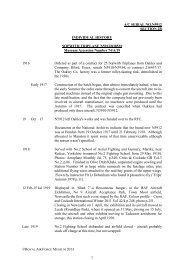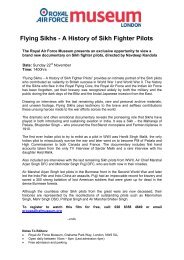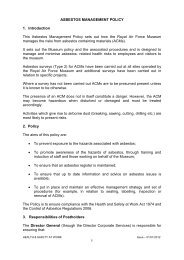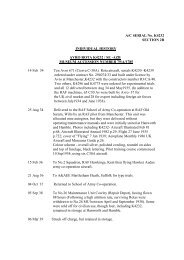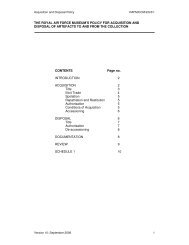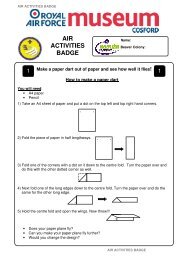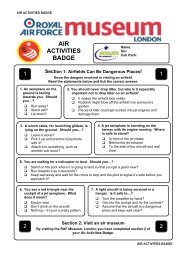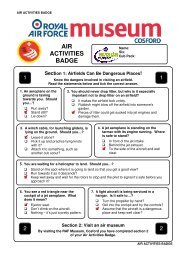Site Instructions and Safety Regulations for Contractors Aug 2012
Site Instructions and Safety Regulations for Contractors Aug 2012
Site Instructions and Safety Regulations for Contractors Aug 2012
Create successful ePaper yourself
Turn your PDF publications into a flip-book with our unique Google optimized e-Paper software.
that members of the public are listening <strong>and</strong> watching your actions; children may<br />
pick up tools left lying around or injure themselves if machines are left with power<br />
supplies on when unattended. Ladders <strong>and</strong> scaffolding can also attract children.<br />
They must not be left unattended. They must either be removed or physically<br />
prevented from being used.<br />
a) Mobile Elevated Work Plat<strong>for</strong>ms (MEWP): Museum owned or hired<br />
MEWP may be used by contractors with prior approval. Operators must<br />
hold a relevant photo ID/training certificate, (see below) <strong>and</strong> have<br />
written permission from their employer to use the equipment. The<br />
Museum will not accept responsibility from any incident relating to<br />
contractor’s misuse of the equipment. When working overhead,<br />
operators will be required to tie all tools to access equipment or to belts<br />
or the like so that they cannot be dropped onto items below. Operators<br />
must wear safety harnesses <strong>and</strong> hard hats with chin strap. A person<br />
must remain at ground level to act as lookout to protect both the<br />
operators <strong>and</strong> persons <strong>and</strong> objects below. The area of operation must<br />
be protected with barriers to stop people w<strong>and</strong>ering into the work area.<br />
b) All MEWP <strong>and</strong> other plant, e.g. Forklift trucks, shall only be driven <strong>and</strong><br />
operated by persons who hold a photographic ID <strong>and</strong> proof of training<br />
by an accredited firm <strong>for</strong> the type unit that they will be operating.<br />
c) Movement of large exhibits: Where the risk of damage is considered<br />
too great or <strong>for</strong> reasons of difficult access, aircraft or artefacts will be<br />
moved. This often requires careful advance planning however <strong>and</strong><br />
cannot be done at short notice.<br />
d) Protection, dust covers <strong>and</strong> the like: Working areas must be properly<br />
<strong>and</strong> adequately protected. Methods of protection must be agreed in<br />
advance. Where polythene is to be used to protect floors it must be<br />
non-slip. Where extra protection is required, it shall be overlaid with<br />
hardboard. Polythene must not be laid directly over aircraft <strong>and</strong> some<br />
other exhibits as it may scratch the surface. Clean dust sheets shall be<br />
used to protect these surfaces <strong>and</strong> then covered with polythene. A<br />
member of our curatorial staff must be present to supervise operations<br />
to cover <strong>and</strong> protect aircraft <strong>and</strong> exhibits. On no account must any<br />
attempt be made to cover fabric-covered aircraft.<br />
8. Working in Office Areas: Most of the above applies equally to offices. Particular<br />
care must be taken to protect computers <strong>and</strong> other electrical equipment that may be<br />
affected by dust. Do not work in offices without permission. Do not attempt to move<br />
personal belongings or equipment. You should be given every assistance to ensure<br />
the working area is ready <strong>for</strong> you. Contact the Building Management staff in case of<br />
any difficulty.<br />
9. Restrictions:<br />
a) Movement around the <strong>Site</strong> <strong>and</strong> Vehicle Access: Comply with speed<br />
limits <strong>and</strong> parking restrictions. Every ef<strong>for</strong>t will be made to allow<br />
HEALTH & SAFETY AT WORK Issue – 01/08/<strong>2012</strong><br />
- 6 -



